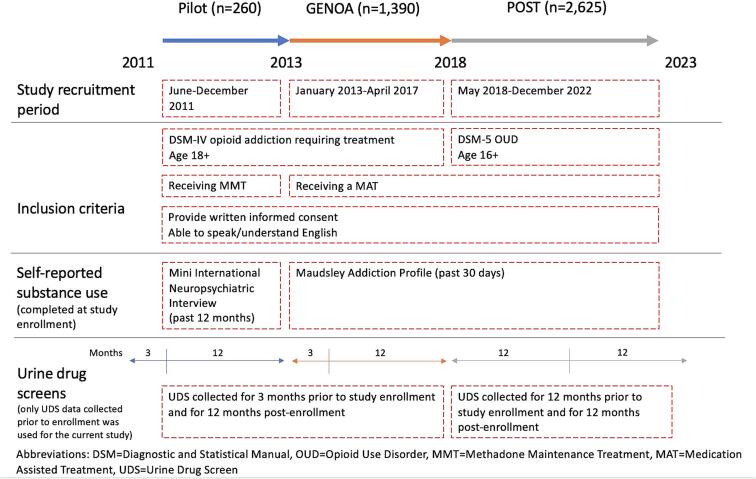在阿片类药物成瘾治疗中我们是否需要尿液药物筛查:一项关于自我报告与尿液药物筛查的观察性研究。
IF 2.8
Q1 Psychology
引用次数: 0
摘要
背景:药物使用危机持续发展。阿片类药物使用障碍(mod)的药物处方是为了减少阿片类药物的使用和相关危害;然而,许多人在治疗期间继续使用药物。本研究的目的是描述自我报告和尿液检测物质之间的协议的时间和人口趋势。方法:本研究是对一项前瞻性队列研究(Pilot 2011,阿片类药物成瘾遗传学(GENOA) 2013-2017,阿片类药物替代治疗药物遗传学(POST) 2018-2022)的三个阶段进行回顾性二次分析。我们比较了阿片类药物、苯二氮卓类药物、安非他明/甲基苯丙胺(AMP/MET)和可卡因的自我报告物质使用数据与尿液药物结果。我们比较了(1)不同药物之间的阳性预测值(PPV)、误漏率(FOR)、敏感性和特异性;(二)按性别分列,(三)研究各阶段入组时的年龄组,使用基线时自我报告的药物使用情况,以及同期收集的尿液药物筛查的回顾性电子健康记录数据。结果:总体而言,各期药物的平均PPV和FOR分别为80.7%和37.9%。可卡因的敏感性和特异性最高,苯二氮卓类药物最低。我们没有发现按性别划分的具体趋势。最后,我们发现与其他年龄组相比,25岁以下的人对阿片类药物和AMP/MET的敏感性更高。苯二氮卓类药物、AMP/MET和可卡因的PPV随着时间的推移而增加,试验和后期阶段的for高于热那亚阶段。结论:我们的研究强调了与确定接受mod的个体的物质使用行为相关的独特挑战,表明许多患者会准确地报告物质使用情况,而其他患者则没有。因此,重要的是要考虑患者的情况,以及用于选择以患者为中心的检测的共同物质的类型。因此,在某些情况下,我们是否需要尿液药物筛查这个问题的答案是肯定的。本文章由计算机程序翻译,如有差异,请以英文原文为准。



Do we need urine drug screens in opioid addiction treatment: An observational study on self-report versus urine drug screens
Background
The substance use crisis continues to progress. Medication for Opioid Use Disorder (MOUD) are prescribed to reduce opioid use and related harms; however, many individuals continue to use substances while on treatment. The objective of this study was to describe the temporal and demographic trends of the agreement between self-reported and urine tested substances.
Methods
The current study is a retrospective secondary analysis of three phases of a prospective cohort study (Pilot 2011, Genetics of opioid addiction (GENOA) 2013–2017, and Pharmacogenetics of opioid substitution treatment (POST)) 2018–2022) spanning 2011–2022. We compared the self-reported substance use data for opioids, benzodiazepines, amphetamine/methamphetamine (AMP/MET), and cocaine with urine drug results. We compared the positive predictive value (PPV), false omission rate (FOR), sensitivity, and specificity between (i) different drugs; (ii) by sex, and (iii) age group at enrollment in each phase of the study using self-reported substance use at baseline and retrospective electronic health record data on urine drug screenings collected over the same time period.
Results
Overall, the average PPV and FOR for any drug across all phases was 80.7 % and 37.9 %, respectively. Sensitivity and specificity were highest for cocaine and lowest for benzodiazepines. We found no specific trend by sex. Lastly, we found a higher sensitivity for opioids and AMP/MET in those under 25 years of age compared to other age groups. PPV increased over time for benzodiazepines, AMP/MET and cocaine and FOR was higher during the pilot and POST phases than the GENOA phase.
Conclusion
Our study highlights the unique challenges associated with ascertaining substance use behaviour for individuals receiving MOUD, indicating many patients will accurately report substance use while others do not. It is therefore important to consider the context of the patient, and the type of the co-substance used to select patient-centred testing as indicated. Therefore, the answer to the question of do we need urine drug screen is yes in some cases.
求助全文
通过发布文献求助,成功后即可免费获取论文全文。
去求助
来源期刊

Addictive Behaviors Reports
Medicine-Psychiatry and Mental Health
CiteScore
6.80
自引率
0.00%
发文量
69
审稿时长
71 days
期刊介绍:
Addictive Behaviors Reports is an open-access and peer reviewed online-only journal offering an interdisciplinary forum for the publication of research in addictive behaviors. The journal accepts submissions that are scientifically sound on all forms of addictive behavior (alcohol, drugs, gambling, Internet, nicotine and technology) with a primary focus on behavioral and psychosocial research. The emphasis of the journal is primarily empirical. That is, sound experimental design combined with valid, reliable assessment and evaluation procedures are a requisite for acceptance. We are particularly interested in ''non-traditional'', innovative and empirically oriented research such as negative/null data papers, replication studies, case reports on novel treatments, and cross-cultural research. Studies that might encourage new lines of inquiry as well as scholarly commentaries on topical issues, systematic reviews, and mini reviews are also very much encouraged. We also welcome multimedia submissions that incorporate video or audio components to better display methodology or findings.
 求助内容:
求助内容: 应助结果提醒方式:
应助结果提醒方式:


